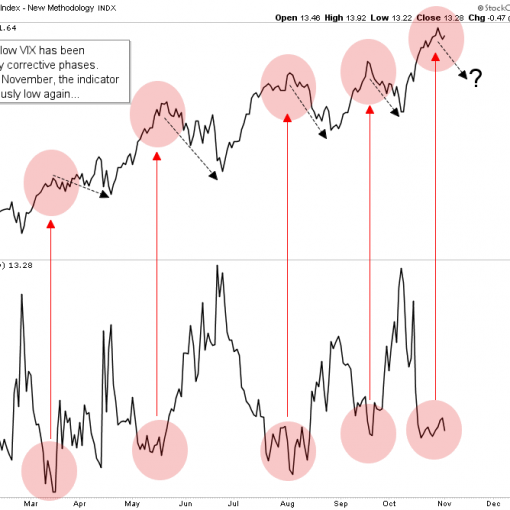 Author: Paul Franke, Quantemonics
Author: Paul Franke, Quantemonics
Covestor model: Relative Value
Disclosures: None
The recently released car sales numbers are very worrisome for the economy and stock market. Sales have fallen from consistent growth during the beginning of 2011 to a declining number in May.
Considering the existing negative wealth and confidence effects from falling real estate prices and sharply higher inflation in early 2011, retail sales turning down now may push the U.S. economy into reverse by late summer. During the first part of 2011, overly optimistic pundits and economists have tried to ignore the negative wealth and income effects from large cost of living increases in commodities and imported goods. Sharply higher inflation rates and expectations of such have been caused by the mindless and disingenuous Quantitative Easing (QE2) scheme launched by the U.S. Federal Reserve (Fed) in the autumn of 2010 to prop up the pricing of stocks and real estate. The Dollar has fallen considerably in value, inflating the import pricing for our economy in the U.S., as a direct result of QE2 and lost faith in bankers running the Fed. Many commodities are nearing shortage situations as speculation and hoarding by companies have been encouraged by QE2 and promises of more of the same.
Yet Fed Chairman Ben Bernanke is already on the record in the past month stating that further easing and money printing after QE2 ends in a few weeks may destabilize the economy and would surely be counterproductive. Eureka moment? The Federal Reserve’s hands are now tied neatly in a bundle of inaction, moving into a potential budget stalemate and Treasury default in early August. I am afraid that by creating mountains of moral hazard with Ponzi money printing since October, the Fed’s high level of credibility has been spent to prop up economic output and stock wealth for several quarters at best. But at what cost to our long-term future? We may soon find out.
I thought I would write a little about the reasoning for our macro, overall stock market exposure caution. Many of the important intermediate and long-term indicators we chart are signaling investors are now fully invested, without (1) much fear of the future or (2) money on the sidelines left to invest in 2011-2012. From a contrarian standpoint, the logic and odds tell us the fuel for buyers overwhelming sellers day after day (the necessary supply/demand ingredient for rising prices) is waning quickly. The odds now favor a shift toward greater imbalance of sellers versus buyers, with a requisite decline in prices over time.
One of our favorite valuation indicators is a ratio comparison of the total U.S. stock market value (capitalization) versus annual GDP economic output by America. We believe this may be the single best long-term indicator of how expensive or cheap stocks really are. For this data from the World Bank, see this page: http://data.worldbank.org/indicator/CM.MKT.LCAP.GD.ZS
Looking at the current market to GDP position, as of 1Q 2011 stocks appear to be on the more expensive side overall, historically. The problem with this ratio going forward is economic growth may actually move into reverse again (recession), meaning if stocks just hold onto their huge price gains since March 2009, the market/GDP value could easily drift into an overvaluation area in the next year or two. Consequently, the odds favor a rather large stock market decline in price from here, if the economy goes into reverse and business profitability slides.
While stock market capitalization to GDP is worrisome, other indicators are raising even bigger red flags in early 2011. Stock market speculation is the highest since the important 2007 or all-time 2000 peak years, based on a combination of sentiment indicators that we use. Here are six of them:
1. Mutual fund cash holdings as a percentage of total assets have been near record lows the past year and a half. At 3.4% as of April, 2011, mutual funds that focus on stock investments have been almost fully invested for many months and have almost no wiggle room if investors decide to liquidate/sell. Given a recession or “Black Swan” event that shakes investor confidence, redemption orders to mutual funds cannot be met with existing cash on hand. Mutual funds would be forced to sell stock holdings, similar to a margin call event for speculators using borrowed money, regardless of price or value received.
2. Total margin debt levels by speculators that borrow money to buy stocks are nearing the record nominal level of 2007 just before stocks fell hard over the following two years. The current $320 billion number is somewhat lower than the $380 billion record in July 2007, but is equal to the whole year 2007’s average reading.
3. More worrisome is the ratio of margin debt to credit available in margin accounts. According to this indicator, speculators are the most fully invested since October 2000 (right after the technology bubble peaked), just as a big bear stock market price decline was beginning. While the nominal dollar level of margin debt has changed over the years with inflation, investors and analysts can construct useful relative ratios of margin debt to help identify investor sentiment. Based on our work with several of these in-house created ratios, real caution is now warranted for stock investors.
4. We also keep track of weekly put/call option trading activity on both individual equities and index products. Options trading history is shorter than most of our other indicators, as they were not actively traded on exchanges or accepted by small investors until the 1970s and 1980s. Consistent trading data started in the mid-1980s. Put options are a right to sell a stock at a certain price for a predefined length of time, while call options give investors the right to buy a stock at a predetermined price for a length of time until expiration. In the first part of 2011, many intermediate-term option moving average indicators highlighted the greatest level of investment optimism in years (more calls bought than puts). Basically, the high level of call buying in early 2011 is on par historically with a fully invested position for investors, both individuals and institutions, leaving little room for economic forecasting error.
5. Numerous sentiment surveys in early 2011 have signaled trouble ahead also. Several straightforward surveys of sentiment and current stock market allocation of capital have been kept for decades at many organizations. Whether looking at traders, investment advisors, individual investors, or institutions, every popular survey has reached extremes in optimism at some point the last 6 months.
Typically, extremes in bullish response occur at major stock market tops and bearish responses are recorded near bottoms in price. At extremes, a contrarian view and swimming against crowd behavior has proven a smart investment stance to take. Holding steady for months, investors have been steadfastly optimistic with their investments for a prolonged period of time. This is a sign that investors and advisors have reached a fully invested state, and have little or no additional money to put into stocks during the coming months. In fact, advisors and investors are at such a high reading of optimism, it will not take much for the cycle to turn down in emotions from this lofty level of confidence. From a scientific, supply/demand reality, the natural odds of sellers overwhelming buyers are high and growing in the summer months, as cycle/season swings in human feelings and sentiment occur.
6. During the past decade, the Chicago Board Options Exchange Volatility Index (VIX), a fear and complacency gauge of volatility in daily price swings for the S&P 500 stocks, has become popular to follow – see CBOE data here: http://www.cboe.com/micro/VIX/vixintro.aspx. Ranging from a 150 high in the days after the October 1987 stock market crash, to lows around 10 in the mid-1990s and 2006, readings under 20 have occurred at nearly every important intermediate-term peak in pricing the last 25 years of real-time use and calculation. During most of calendar 2011, we have been below 20, to as low as 14 in April. The average number for the VIX over decades of history is about 24. For context, the VIX reading was 16 in May 2008 before the real estate derivatives bubble completely burst, rising to a high of 80 right after Lehman Brothers was allowed to fail in October and November 2008. The VIX is not the best long-term indicator of past or future price changes. It is more a record of current “expected” returns and volatility in the coming weeks for stocks. As such, it is now highlighting an abnormally low expectation of daily price volatility, alongside rising stock prices.
Individually the above six indicators have excellent track records in signaling trouble ahead for stock investors. In the first half of 2011, ALL SIX are screaming for lower than typical stock market exposure, and Quantemonics Investing is listening. Any type of negative news flow or event could lead to selling volumes greater than buying volumes in the near future, producing falling prices for stocks generally. We have plenty of potential sell triggers to choose from, during the summer and autumn, including government defaults on sovereign debt, slashed federal and state spending in the U.S. economy, a lower and steadily declining Dollar value, rising oil prices and overall inflation, climbing interest rates, new trade wars involving the U.S., and more. If history is a guide, any substantial trigger from this fully invested state could easily push stocks into a bear market decline.
Our computer models suggest a range of possible futures between +10% and -30% for the U.S. stock market during the remainder of 2011 and early 2012, with a mean expected total return of -10% to -15% from June 2011 to June 2012. As a consequence of our numbers and trading experience, we believe a more cautious approach to investing and low net stock market exposure are the intelligent option today.
Our Covestor account battle plan is to slowly increase exposure as the market declines, by investing our cash holdings and converting the short ETF products we currently own as hedges into regular stocks.
– Paul Franke
Sources:
Barron’s Pulse of the Economy, 6/6/11 http://online.barrons.com/public/page/9_0210-pulseoftheeconomy.html
“May Auto Sales – Another Sign of a Stalling Economy“ 6/1/11, Agustino Fontevecchia, Forbes.comhttp://blogs.forbes.com/afontevecchia/2011/06/01/may–auto–sales–another–sign–of–a–stalling–economy/?partner=yahootix
Wilshire Indexes for Wilshire 5000, as of 5/31/2011. http://web.wilshire.com/Indexes/Broad/Wilshire5000/Characteristics.html
“Table 1.1.5. Gross Domestic Product” U.S. BEA for GDP http://www.bea.gov/national/nipaweb/TableView.asp?SelectedTable=5&FirstYear=2010&LastYear=2011&Freq=Qtr
“Securities market credit ($ in mils.), All Years” NYSE http://www.nyxdata.com/nysedata/asp/factbook/viewer_edition.asp?mode=tables&key=50&category=8
“Trends in Mutual Fund Investing” Investment Company Institute http://ici.org/research/stats/trends/trends_04_11
“CBOE Market Report” Barron’s, http://online.barrons.com/public/page/9_0210-cboemktrt.html, data from CBOE Market Report http://www.cboe.com/data/PutCallRatio.aspx
Barron’s Investment Sentiment Ratings, June 13, 2011http://online.barrons.com/public/page/9_0210-investorsentimentreadings.html


